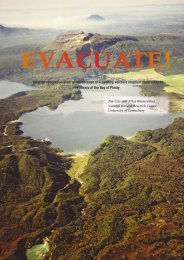Volcanoes - Ministry of Civil Defence and Emergency Management
Volcanoes - Ministry of Civil Defence and Emergency Management
Volcanoes - Ministry of Civil Defence and Emergency Management
Create successful ePaper yourself
Turn your PDF publications into a flip-book with our unique Google optimized e-Paper software.
The psychological,<br />
social, cultural,<br />
institutional <strong>and</strong> political<br />
processes influencing<br />
how individuals <strong>and</strong><br />
communities think<br />
about volcanic risk must<br />
be understood. Risk<br />
perception is important<br />
in the preparedness<br />
process, as it is needed to<br />
initially motivate people<br />
into preparing for hazard<br />
events, <strong>and</strong> needs to be<br />
adequately raised before<br />
people will contemplate<br />
making their homes<br />
<strong>and</strong> families safer. It is,<br />
therefore, essential that<br />
before embarking on<br />
new campaigns, means <strong>of</strong><br />
A number <strong>of</strong> agencies such as GNS, the Earthquake Commission, <strong>and</strong> the Department <strong>of</strong> Conversation Conservation are<br />
changing <strong>and</strong> assessing the<br />
working together on with initiatives civil defence to raise staff public on initiatives underst<strong>and</strong>ing to raise <strong>of</strong> public volcanic underst<strong>and</strong>ing hazards. <strong>of</strong> volcanic hazards.<br />
public’s risk perception be<br />
thoroughly explored so<br />
zones, 24% aware <strong>of</strong> some <strong>and</strong> 72% not knowing<br />
they do not revert to old, ineffective ways.<br />
any danger zones. Even though volcanic hazard risk<br />
REFERENCES<br />
perception <strong>and</strong> awareness is increasing amongst patrons<br />
<strong>of</strong> the Whakapapa ski area, it once again has not led<br />
Ballantyne, M., Paton, D., Johnston, D., Kozuch,<br />
to ‘better prepared skiers’ as they are not seeking out<br />
M. <strong>and</strong> Daly, M., 2000. Information on volcanic <strong>and</strong><br />
where these hazards will occur. In an attempt to solve<br />
earthquake hazards: The impact on awareness <strong>and</strong><br />
this problem, Ruapehu Alpine Lifts, DoC, GNS <strong>and</strong><br />
preparation. 2000/2, Institute <strong>of</strong> Geological <strong>and</strong> Nuclear<br />
civil defence have produced posters <strong>and</strong> fact sheets on<br />
Sciences, Wellington.<br />
volcanic hazards at Whakapapa, which include a large<br />
Finnis, in preparation. Resilience <strong>and</strong><br />
map clearly illustrating where hazards are likely to<br />
Vulnerability in Communities Around Mt Taranaki. PhD<br />
occur, for distribution during the 2004 ski season.<br />
Thesis, University <strong>of</strong> Otago, Dunedin.<br />
Galley, I., Paton, D., Johnston, D.M. <strong>and</strong> Becker,<br />
CONCLUSION<br />
J., 2003. Lahar response management at Whakapapa<br />
In general, the data to date show that the<br />
Ski Field, Ruapehu: staff development <strong>and</strong> public safety.<br />
underst<strong>and</strong>ing <strong>of</strong> the volcanic risk by residents<br />
2003/6, Institute <strong>of</strong> Geological <strong>and</strong> Nuclear Sciences,<br />
threatened by the effects <strong>of</strong> volcanic eruptions <strong>and</strong><br />
Lower Hutt.<br />
associated hazards needs improving. Factors such as<br />
Johnston, D.M., Bebbington, M.S., Lai, C.-D.,<br />
threat knowledge, proximity to volcano, perceived<br />
Houghton, B.F. <strong>and</strong> Paton, D., 1999. Volcanic hazard<br />
likelihood <strong>of</strong> future disasters, level <strong>of</strong> impact <strong>and</strong> past<br />
perceptions: comparative shifts in knowledge <strong>and</strong> risk.<br />
experiences <strong>of</strong> disaster impact, which are commonly<br />
Disaster Prevention <strong>and</strong> <strong>Management</strong>, 8(2): 118-126.<br />
used to determine risk perceptions, do not particularly<br />
Leonard, G.S., Johnston, D.M. <strong>and</strong> Paton, D.,<br />
hold for these populations.<br />
2004. Mitigating the lahar risk at Whakapapa Ski Area,<br />
In order to change people’s risk perceptions<br />
Mt. Ruapehu: Public perceptions <strong>and</strong> the effectiveness<br />
future work should not only concentrate on providing<br />
<strong>of</strong> the new warning system. 2004/02, Institute <strong>of</strong><br />
scientific information on the hazards. Nor should it<br />
Geological <strong>and</strong> Nuclear Sciences, Lower Hutt.<br />
be expected that residents in communities who have<br />
Sheehy, A., 2002. A Study <strong>of</strong> the Perceived<br />
been previously impacted by an event or live with<br />
Risks <strong>of</strong> Tephra Fall Hazards in Auckl<strong>and</strong>, New<br />
the constant or close reminder <strong>of</strong> volcanic activity<br />
Zeal<strong>and</strong>. Masters Thesis, University <strong>of</strong> Auckl<strong>and</strong>,<br />
automatically have high risk perceptions (leading to the<br />
Auckl<strong>and</strong>, 122 pp.<br />
expectation that they will be more ready for an event).<br />
64<br />
TEPHRA<br />
June 2004

















